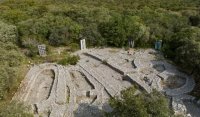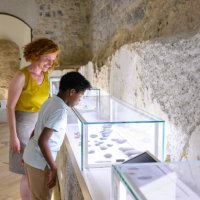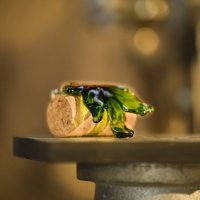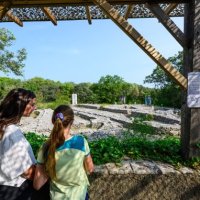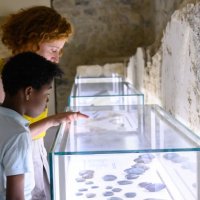Site de Cambous
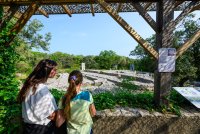

The Cambous archaeological site is home to the ruins of a prehistoric village that is probably the oldest village you can visit in France.
The Cambous site sheds light on a pivotal period in our history. At the end of prehistory, a profound change began, with the transition from a way of life based on hunting and gathering to agriculture and livestock farming.
These new agro-pastoral activities led to a sedentary lifestyle that was accompanied by numerous technical innovations. This is the story told by the village of Cambous, and it's also a bit of the story of the Grand Pic Saint-Loup.
The Cambous site is also remarkable for its state of preservation.
Built of stone, unlike most wooden structures of the period, it is considered to be one of the oldest villages in France still visible. It has been fitted out to receive visitors, including the reconstruction of a dwelling from the period, and is also a laboratory for archaeological studies and excavations.
It specialises in experimental archaeology, which involves reproducing prehistoric skills and techniques to better understand how they evolved.
During the "Faîtes de la préhistoire" event (in May), the European Archaeology Days (in June) and the European Heritage Days (in September), numerous activities are presented to the public, who are then invited to take part in them on these entirely free days.
It dates from the Chalcolithic (or Copper Age), a period between 2700 and 2300 BC. During these four centuries, a brilliant culture flourished, known as the Fontbouisse culture, named after a site in the Sommières region (Gard) where similar remains were studied in the 1940s.
In the Garrigues (regions of limestone hills where garrigue grows) of the Gard, Hérault and Ardèche, the Fontbouisse people have built countless dolmens and villages with stone houses. There are over two hundred hamlets of this type, but barely 20% have been studied by archaeologists. There's still a lot of work to be done, and the Cambous site is just one example of the research being carried out in these regions.

Its remarkable state of preservation is due to its construction technique: unlike the Neolithic houses built in most parts of France, Cambous was not built in clay and wood, perishable materials, but in dry stone.
Four groups of eight to ten huts each were uncovered from 1967 onwards. The adjoining dwellings have thick stone and lauze walls and an elongated plan with apse-shaped ends: this architecture is typical of the people of Fontbouisse.
A dwelling with a thatched and lauze roof has been reconstructed on the outskirts of the site.
Here, and nowhere else, a fossilised territory has survived for almost five millennia, offering itself up to the astonished gaze of researchers and visitors alike.

Temporary exhibition 2023
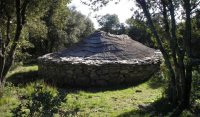
« L’œil de l’archéologue #2 » - Exposition Temporaire
Objects from archaeological digs are a real source of knowledge. A modest detail, sometimes invisible to the naked eye, can turn out to be precious information for the archaeologist. The precise observation of a copper knife, a bone bead, a richly decorated vase and the practice of archaeological experimentation take us back to the daily life of our distant ancestors, to manufacturing techniques, agriculture, animal husbandry, hunting and everyday life, but also to beliefs and rites.

This exhibition of very large-format photographs takes us on a journey to retrace the footsteps of our origins. While the houses abandoned 5,000 years ago bear witness to a bygone age, the objects forgotten by our ancestors tell us of a world that is still very much alive!
This exhibition is organised by the Société Languedocienne de Préhistoire, with the support of the Communauté de communes du Grand Pic Saint-Loup.
From 1 April to 29 October 2023, the Cambous archaeological site will be hosting the "L'œil de l'archéologue#2" exhibition, inviting us to contemplate, through the eye of the archaeologist, the invisible messages left by prehistoric objects.
Price
- General admission : 4 €
- Concesion : 2 € (6-18 year olds, students, jobseekers, Pass'Pic card, visitors to Halle du Verre or Maison des Consuls)
- Free under 18s
How to get there
Village préhistorique de Cambous – 34380
- Viols-en-Laval
GPS : N 43.75587 / E 3.73244
Opening hours
The exhibition is open from 1 April to 29 October 2023:
- April to June, September and October:
Saturdays and Sundays from 2 pm to 6 pm - From 1st to 15th July and from 16th to 31st August : daily from 2 pm to 7 pm
- From 16 July to 15 August :
Monday to Thursday, 3pm to 7.30pm
and Friday to Sunday from 9.30 am to 7.30 pm
Informations pratiques
To get to the Cambous Prehistoric Village by bus: line 608, get off at the "Mairie" stop, 850 m on foot.
Accessibility: the path through the garrigue is tricky for people with reduced mobility.
To find out more
